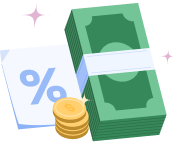As the cost of education continues to rise, many students need financial assistance beyond traditional student loans. Personal loans for students have emerged as a viable option to bridge the financial gap and cover various educational expenses. Get personalized loan options on the Beem app, without worrying about credit score and income restrictions
In this comprehensive guide, we will thoroughly examine the intricacies of personal loans for students. We also draw comparisons between these loans and traditional student loans, delve into their effectiveness in addressing educational debt, outline the advantages and disadvantages they present, and offer a systematic, step-by-step procedure for acquiring them.
Personal Loans vs. Student Loans: What’s the Difference
Allocating Funds
Personal Loans: Versatile funding, but some lenders restrict for secondary education. Careful review is needed. Combining with student loans may be necessary for full coverage.
Student Loans: Designed for education, covering tuition, books, board, and meeting higher education financial needs.
Disbursement and Management of Funds
Personal Loans: Personal loan funds are directly deposited into your account, providing flexibility in allocation but necessitating meticulous budgeting for essential expenses.
Student Loans: Student loans are disbursed to your school’s financial aid office, streamlining payment. The remaining funds can be claimed for other education-related expenses, simplifying financial management.
Lender Options and Loan Types
Personal Loans: Banks, credit unions, and online platforms offer personal loans. Thorough research comparing terms, rates, and repayment conditions ensures optimal choices.
Student Loans: Federal and private student loans offer different benefits. Federal loans come with varied repayment plans, while private loans from institutions like banks cater to individual requirements.
Repayment Strategies and Timing
Personal Loans: Repayment begins shortly after loan receipt, often with shorter terms of one to seven years. This might require balancing work and budgeting.
Student Loans: Repayment often starts post-graduation, offering flexibility. Grace periods and small in-school payments ease the transition into repayment.
Tax Implications and Benefits
Personal Loans: Limited tax benefits are associated with personal loans, even for education.
Student Loans: Student loans may offer tax advantages, such as interest deduction. This aids in reducing overall tax liability, especially as you transition into the workforce.
| Loan Type | Borrower Type | Fixed Interest Rate |
| Direct Subsidized Loans and Direct Unsubsidized Loans | Undergraduate | 5.50% |
| Direct Unsubsidized Loans | Graduate or Professional | 7.05% |
| Direct PLUS Loans | Parents and Graduate or Professional Students | 8.05% |

Can You Use Personal Loans to Pay Student Loans?
Yes, you can use personal loans for students to pay off existing student loans. This approach can provide financial relief and save money on interest, especially if the personal loan offers a lower interest rate than the current student loan.
Using Personal Student Loans for Debt Consolidation: Debt consolidation is a common strategy where students take out a personal loan to pay off multiple student loans. This simplifies the repayment process, as students have only one loan with a potentially lower interest rate. However, it’s crucial to carefully compare interest rates, terms, and any potential fees before opting for this approach.
Refinancing with Personal Loans: Personal student loans can be used for refinancing existing student loans. By refinancing, students can secure a lower interest rate and adjust the repayment terms to better suit their financial situation.
Personal Loans for Students: Pros and Cons
Pros
1. Flexibility: Personal student loans can be used for various educational expenses, offering more flexibility than traditional student loans.
2. No FAFSA Required: Unlike federal student loans, personal loans for students don’t require filling out the Free Application for Federal Student Aid (FAFSA), simplifying the application process.
3. Quick Access: Personal loans often have a faster application and approval process, making them suitable for urgent financial needs.
4. Credit Building: Successfully repaying a personal loan can help students build or grow credit scores, setting them up for better financial opportunities in the future.
Cons
1. Higher Interest Rates: Personal loans typically come with higher interest rates than federal student loans, potentially leading to higher overall borrowing costs.
2. Credit and Income Requirements: Students with a limited credit history or no income might require a co-signer or collateral, which can be a barrier to approval.
3. Limited Repayment Options: Federal student loan repayment options might be more flexible than Personal loan repayment options, which can create challenges during financial difficulty.
4. Lack of Benefits: Federal student loans offer certain benefits like income-driven repayment plans, loan forgiveness programs, and deferment options unavailable with personal loans.
Also know about : Financial Plans
How to Get Personal Loans for Students
- Assess Your Needs: Determine how much money you need and how it will be used. Consider alternative funding sources before resorting to personal loans.
- Research Lenders: Explore various lenders offering personal loans for students. Compare interest rates, terms, and eligibility requirements.
- Check Your Credit: Review your credit score and history. If necessary, consider obtaining a co-signer with good credit to increase your chances of approval for personal loans for students with no income.
- Gather Documentation: Prepare necessary documents, such as identification, proof of enrollment, and any required financial information.
- Apply: Complete the lender’s application process, providing accurate information and required documentation.
- Review Offers: Once approved, carefully review the loan offers and evaluate the interest rates, repayment terms, and associated fees.
- Accept the Loan: Choose the offer that best accommodates your needs and accept the terms.
- Repay Responsibly: Make timely payments to avoid late fees and develop a strong credit history.
Also Know About : Strategies millennials use to pay off student loans

Conclusion
Personal loans for students, often referred to as personal student loans, can be a valuable tool for covering educational expenses beyond what traditional student loans offer. While they provide flexibility and quick access to funds, they also come with certain risks, such as higher interest rates and potential credit requirements. Use Beem to get information on personalized rates and explore loan options ranging from $500 to $100,000, without impacting your credit score. Before pursuing a personal loan, students should carefully weigh the pros and cons and explore alternative funding options. If used wisely and managed responsibly, personal loans for students can serve as a bridge to educational success.
Frequently Asked Questions
1. Can Students With No Income Obtain Personal Loans for Students?
Some lenders offer personal loans for students with no income, typically requiring a co-signer or collateral to secure the loan.
2. Can Students With No Income Obtain Personal Loans for Students?
Personal student loans can be used to pay off existing student loans, especially if they offer better interest rates or repayment terms.
3. How Do Personal Loans for Students Affect Credit Scores?
Successfully repaying personal loans can positively impact students’ credit scores, helping them build a strong credit history for future financial endeavors. However, missed payments can have adverse effects.
















































